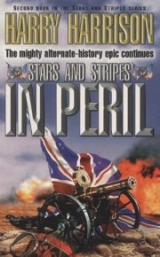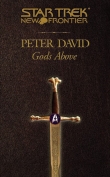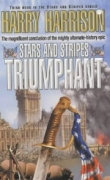
Текст книги "Stars and Stripes In Peril"
Автор книги: Harry Harrison
Жанр:
Альтернативная история
сообщить о нарушении
Текущая страница: 23 (всего у книги 23 страниц)
SPRING – 1863
THE UNITED STATES OF AMERICA
Abraham Lincoln President of the United States
Hannibal Hamlin Vice-President
William H. Seward Secretary of State
Edwin M. Stanton Secretary of War
Gideon Welles Secretary of the Navy
Salmon P. Chase Secretary of the Treasury
Gustavus Fox Assistant Secretary of the Navy
Edward Bates Attorney General
Judah P. Benjamin Secretary for the South
John Nicolay First Secretary to President Lincoln
John Hay Secretary to President Lincoln
William Parker Parrott Gunsmith
John Ericsson Inventor of USS Monitor
Frederick Douglass of the Freedmen’s Bureau
UNITED STATES ARMY
General William Tecumseh Sherman
General Ulysses S. Grant
General Ramsay Head of Ordnance Department
General Robert E. Lee
General Thomas J. “Stonewall” Jackson
General James Longstreet
General Joseph E. Johnston
General Thomas Francis Meagher Commander of the Irish Brigade
Surgeon Francis Reynolds
General Bragg Commander of the Texas Brigade
UNITED STATES NAVY
Commodore Goldsborough Captain of USS Avenger
Rear Admiral David Dickson Porter
Admiral David Glasgow Farragut
Captain Green Captain of USS Hartford
Captain Johns Captain of USS Dictator
Captain Raphael Semmes Captain of USS Virginia
Captain Weaver Captain USS Pawatuck
Captain Eveshaw Captain USS Stalwart
MEXICO
Benito Juarez President of Mexico
Don Ambrosio O’Higgins Revolutionary
General Porfirio Diáz Oaxaca guerrillero chief
General Escobeda Monterrey guerrillero chief
Archduke Maximilian French puppet emperor
GREAT BRITAIN
Victoria Regina Queen of Great Britain and Ireland
Lord Palmerston Prime Minister
Lord John Russell Foreign Secretary
William Gladstone Chancellor of the Exchequer
BRITISH ARMY
Duke of Cambridge Commander-in-Chief
Brigadier Somerville the Duke’s aide
General Arthur Tarbet commander Belfast forces
BRITISH NAVY
Admiral Napier
Vice-Admiral Sawyer
Captain Frederick Durnford Captain HMS Conqueror
Captain Fosbery Captain HMS Valiant
Captain Cockham Captain HMS Intrepid
AFTERWORD
It has been often said that history is written by the victors. True enough. Therefore the student of history must always be aware of not taking sides. But there are certain facts that cannot be juggled by the victors. Numerical records are one of them.
It is a matter of record that, during the two-day Battle of Shiloh, the first conflict of the Civil War where large units clashed face to face, that the North and the South, between them lost 22,000 men. To no avail – since their positions were roughly the same at the end of the battle as they had been before they began. And there was worse to come. By the time the war had ended 200,000 soldiers had been killed in battle. Another 400,000 had died of disease or hardship. The population of the United Sates at the time was around 32,000,000. Which means that around two percent of the total population died in the war.
This was indeed the first modern war, where large formations of soldiers clashed with one another, using advanced technology to achieve these disastrous ends. Modern rifles and cannon in great numbers, railroad trains to supply the armies, telegraph and observation balloons to direct the conflict, ironclad steam-driven ships at sea. 600,000 dead. The Civil War was the first mechanized conflict and the terrible price paid was only a shadow of what was to come.
Of course as the technology of warfare improved so did the death toll. By the time of the First World War the improvements of machine-guns, rapid firing rifles, smokeless gun powder, breech-loading cannon and improved transport had made modern warfare that much more deadly. The Germans had 400,000 casualties on the battle of the Somme; the French lost 500,000 at Verdun. The British lost 20,000 men in a single day in the battle of the Somme – the same number that had been killed during the entire Boer War. Machines were changing the deadly face of warfare.
Not that the generals noticed it. Never known for their imagination, they never quite knew what to do with their new weapons. They were always prepared to fight a new war with the tactics of the previous one.
In the blood-bath of the Civil War the Americans learned by experience how to utilize new tactics and new weapons. Since both sides in the First World War threw away their soldiers’ lives in frontal attacks on entrenched machine-gun positions, I feel completely justified in having them do the same thing in this book, in 1863. It is hard to forget that in 1939 Polish cavalry charged against German tanks. The deeply entrenched attitudes of the martial mind are almost immune to novelty, logic or reason.
The irreducible facts of history speak for themselves. If I appear to be prejudiced about the British in Ireland in the nineteenth century, I do apologize. I have attempted to be as even-handed as I can. Putting historical quotes into my characters’ mouths whenever possible. Avoiding inflammatory facts when I could. Such as the historical fact that Catholics were not allowed to buy land, or raise a mortgage on it – or even inherit it in the normal fashion. At the turn of the 18th century Catholics owned barely 15 percent of the total land in the country, most of that bog and mountain. This was because, by British law, they could not keep their lands intact. When the owner died the land had to be shared equally among all the sons of the owner. However – should any son of the family turn Protestant – everything became his. Therefore by the end of the mid-18th century Catholics, who made up about 90% of the population, owned only 7% of the land. Is it any wonder that they died during the famine on their miserable tiny plots of land – or later rose in revolt?
Lightning war – or blitzkrieg as the Germans called it – was a natural outgrowth of the use of machines of war. When the Allies first introduced tanks to the battlefield during the First World War they had little idea what to do with them. So they came to the battlefield piecemeal and were duly destroyed. By the time of the Spanish Civil War there were self-propelled guns and armored troop carriers. As well as aerial support. The Germans experimented with their joint use and the art of the blitzkrieg was invented. Neither France nor Britain took heed of these developments until it was too late. My Americans in 1863 did what the Germans did in 1936. They applied all the lessons of combat that they had learned the hard way, through he death of soldiers, to invent a new and more successful kind of warfare.








